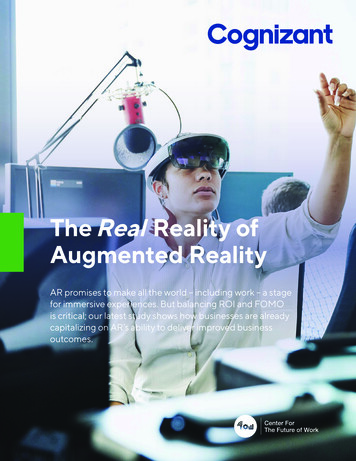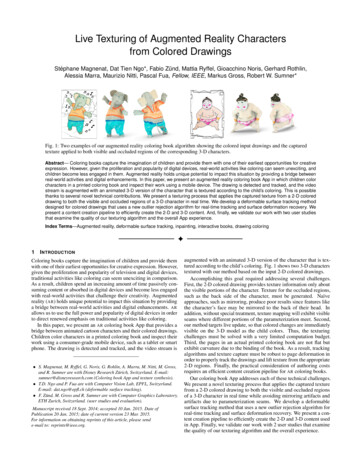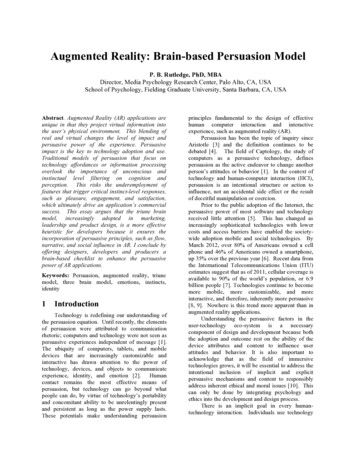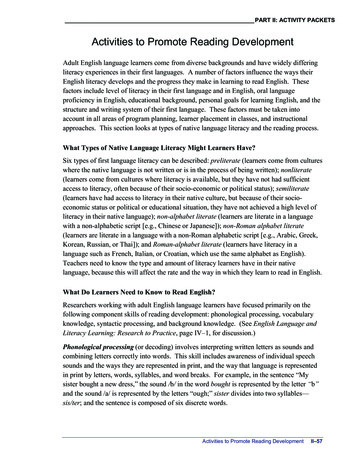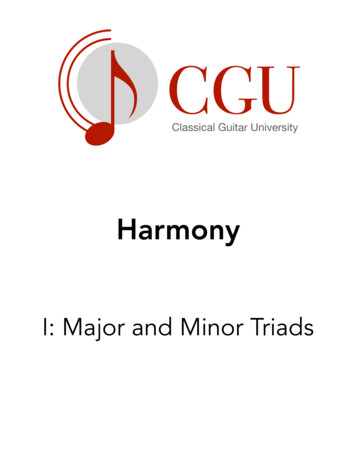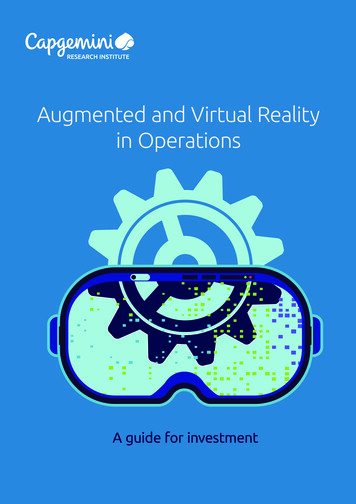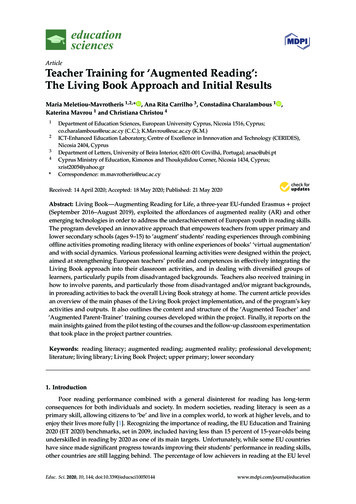
Transcription
educationsciencesArticleTeacher Training for ‘Augmented Reading’:The Living Book Approach and Initial ResultsMaria Meletiou-Mavrotheris 1,2, * , Ana Rita Carrilho 3 , Constadina Charalambous 1 ,Katerina Mavrou 1 and Christiana Christou 41234*Department of Education Sciences, European University Cyprus, Nicosia 1516, Cyprus;co.charalambous@euc.ac.cy (C.C.); K.Mavrou@euc.ac.cy (K.M.)ICT-Enhanced Education Laboratory, Centre of Excellence in Innnovation and Technology (CERIDES),Nicosia 2404, CyprusDepartment of Letters, University of Beira Interior, 6201-001 Covilhã, Portugal; arsac@ubi.ptCyprus Ministry of Education, Kimonos and Thoukydidou Corner, Nicosia 1434, Cyprus;xrist2005@yahoo.grCorrespondence: m.mavrotheris@euc.ac.cyReceived: 14 April 2020; Accepted: 18 May 2020; Published: 21 May 2020 Abstract: Living Book—Augmenting Reading for Life, a three-year EU-funded Erasmus project(September 2016–August 2019), exploited the affordances of augmented reality (AR) and otheremerging technologies in order to address the underachievement of European youth in reading skills.The program developed an innovative approach that empowers teachers from upper primary andlower secondary schools (ages 9–15) to ‘augment’ students’ reading experiences through combiningoffline activities promoting reading literacy with online experiences of books’ ‘virtual augmentation’and with social dynamics. Various professional learning activities were designed within the project,aimed at strengthening European teachers’ profile and competences in effectively integrating theLiving Book approach into their classroom activities, and in dealing with diversified groups oflearners, particularly pupils from disadvantaged backgrounds. Teachers also received training inhow to involve parents, and particularly those from disadvantaged and/or migrant backgrounds,in proreading activities to back the overall Living Book strategy at home. The current article providesan overview of the main phases of the Living Book project implementation, and of the program’s keyactivities and outputs. It also outlines the content and structure of the ‘Augmented Teacher’ and‘Augmented Parent-Trainer’ training courses developed within the project. Finally, it reports on themain insights gained from the pilot testing of the courses and the follow-up classroom experimentationthat took place in the project partner countries.Keywords: reading literacy; augmented reading; augmented reality; professional development;literature; living library; Living Book Project; upper primary; lower secondary1. IntroductionPoor reading performance combined with a general disinterest for reading has long-termconsequences for both individuals and society. In modern societies, reading literacy is seen as aprimary skill, allowing citizens to ‘be’ and live in a complex world, to work at higher levels, and toenjoy their lives more fully [1]. Recognizing the importance of reading, the EU Education and Training2020 (ET 2020) benchmarks, set in 2009, included having less than 15 percent of 15-year-olds beingunderskilled in reading by 2020 as one of its main targets. Unfortunately, while some EU countrieshave since made significant progress towards improving their students’ performance in reading skills,other countries are still lagging behind. The percentage of low achievers in reading at the EU levelEduc. Sci. 2020, 10, 144; ucation
Educ. Sci. 2020, 10, 1442 of 25has actually grown in recent years, from 17.8 percent in 2012 to 21.7 percent in 2018, annulling allthe progress made since 2009, when it was also 19.5 percent [2]. According to the PISA 2018 results,only four EU Member States (Estonia, Ireland, Finland, and Poland) met the ET 2020 benchmark of lessthan 15 percent underachievement in reading.Technological advances provide the opportunity to implement innovative methodologies moresuited to the needs of 21st century learners [3], and to create entirely new, student-centered learningenvironments [4]. These new developments can boost students’ reading engagement by significantlyincreasing the range and sophistication of possible classroom activities [5]. One promising approachthat has been explored lately is the use of augmented reality (AR) tools and applications. AR is anemerging form of reality that enhances individuals’ experiences of the real world by overlaying locationor context-sensitive virtual information (e.g., text, images, videos, animations with sound, etc.) ontoelements of the physical environment [6]. AR incorporates a broad continuum of computer-generatedsensory input (e.g., video, graphics, sound, GPS data) to project virtual content onto users’ perceptionsof the real world. It has three fundamental characteristics [7]: (i) combination of real-world and virtualelements; (ii) interaction in real time; (iii) registration in three-dimensional space (i.e., 3D virtualelements intrinsically tied to real-world loci and orientation).AR has gained a growing interest among researchers during the past few years, especially in thefield of education [8–12]. In particular, AR books, which combine physical books with the interactivepotentials provided by digital media, constitute a playful and engaging way for enhancing teachingand learning. Although the amount of available research concerning the integration of AR books intoteaching and learning is still relatively small due to the novelty of these technologies, the majority ofexisting studies overwhelmingly point towards numerous positive attributes that have the potential toenhance both formal and informal student learning. The results of these studies demonstrate that theseamless interconnection of the virtual and the real world offered by AR books makes the learningprocess more relevant and enjoyable for the majority of students, including learners with diverseeducational needs. This, in turn, helps to increase students’ motivation and engagement in learning,and to improve their story comprehension performance [13–20].Exploiting important affordances of AR environments such as realism, immersion, and situationalawareness, has been found to improve students’ conceptual understanding [21]. By enabling users tomanipulate virtual objects while, at the same time, interacting with real-world surroundings, AR bookspromote authentic learning and ‘learning by doing’, utilizing visualisations to make abstract conceptsmore tangible and concrete [22]. AR also focuses students’ attention on the learning process [23],providing opportunities for more authentic and situated learning [24,25], which can be useful forhelping students develop contextual awareness [26].The existing literature also suggests that the affordances provided through the wide range ofmodalities offered by AR books favor the principles of universal design for learning in relation tomultiple means of representation, of action, and of engaging all learners in the educational process [27].AR books can support all learners (including those with reading difficulties, emotional and behaviouraldifficulties, low motivation, etc.) as the integration of multiple modalities allows students to learnbased on their preferred learning style [9]. Moreover, engagement with AR books and other relevantAR-supported learning activities (e.g., digital storytelling, animation making, game development),can reinforce important 21st century skills, such as communication, interpersonal and social skills,problem solving, creativity, and innovation.The EU-funded Erasmus /KA2 project The Living Book—Augmenting Reading for Life project(September 2016–August 2019) was proposed in an attempt to exploit the affordances of AR and otheremerging technologies in order to address the underachievement of European students aged 9–15 inreading skills. The project consortium was comprised of nine partner organizations originating from sixdifferent EU countries (Cyprus, Estonia, Italy, Romania, Portugal, UK). In most of the partner countries,the proportion of low achievers in reading is still dramatically high (European Commission, 2019):Cyprus (43.7%), Romania (40.8%), Italy (23.3%), Portugal (20.2%). Groups with low performance tend to
Educ. Sci. 2020, 10, 1443 of 25be students from socioeconomically disadvantaged families, with less well-educated parents, and withimmigrant backgrounds. The project’s overall aim was to increase these young people’s motivationto read, while at the same time also boosting a cluster of other key and transversal competenciesin students (e.g., digital skills, learning to learn, critical thinking, cooperative skills). Living Bookaspired to achieve this through the development of a novel pedagogical approach that combines offlineactivities promoting reading literacy with online experiences of ‘virtual augmentation’ of a book andwith social dynamics.The Living Book consortium has reached out to European teachers to inform them aboutAR and other technological developments that could be utilized in schools to augment students’reading experience with rich media content. A main output of the project is the “AugmentedTeacher” professional development course, which targets in-service teachers of upper primary andlower secondary school (ages 9–15). Through a combination of open educational resources (OER)and involvement in professional learning activities, the course aims at strengthening the profileand competences of European teachers in effectively integrating the Living Book approach intotheir classroom activities. In parallel, the project has developed the “Augmented Parent-Trainer”course, which provides training to teachers in how to involve parents, and particularly those fromdisadvantaged and/or migrant backgrounds, in proreading activities to back the overall Living Bookstrategy at home. A Living Library (http://thelivinglibrary.eu/) has supported the project activities byoffering students, parents, and teachers with online tools to augment the reading experience with richmedia content. The Living Library also hosts a social community of “augmented teachers” and a socialcommunity of young “augmented readers”.This article provides an overview of the Living Book project. It first gives a synopsis of thekey activities and outputs of the project. Next, it describes the design of the Augmented Teacherand Augmented Parent-Trainer courses. It then reports on the main experiences gained from thepilot testing and follow-up classroom experimentation process that took place in four of the partnercountries (Cyprus, Estonia, Portugal, Romania) in order to evaluate the level of success of theprofessional development program. The article concludes with some implications for teaching and forfuture research.2. Overview of Living Book Activities and OutputsIn the three-year timeframe of the Living Book program, the following activities took place inorder to achieve the project objectives:2.1. Development of Living Book Methodological GuidelinesAt the outset of the project, the consortium developed an e-publication providing teachers (andother relevant stakeholders) with theoretical and methodological guidelines to implement the LivingBook approach. The guidelines offer the methodological framework for increasing pupils’ reading skillsand motivation to read, and for making an appropriate use of ICT and new digital technologies for thispurpose. In particular, they describe The Living Book approach, which combines unplugged activitiespromoting reading literacy with experiences of “virtual augmentation” of a book and strengthening ofdigital skills, and with social dynamics leading to the creation of European communities of youngaugmented readers. To foster young people’s motivation to read, the guidelines also suggest integrativeactivities for students with disadvantaged and migrant backgrounds who need to be motivated toread as a vehicle for integration, inclusion, and prevention of early school leaving. They also suggestthe methodological approach and strategies to support reading at home. Moreover, the guidelinescomprise a framework and appropriate tools for identifying and assessing the competences of theaugmented reader. The e-publication containing the guidelines is freely available for European teachersand downloadable on any device (https://thelivingbook.eu/).
Educ. Sci. 2020, 10, 1444 of 252.2. Development of Augmented Teacher and Augmented Parent-Trainer Course ContentBased on the Living Book Methodological Guidelines, the consortium next designed and developeda line of research-based curricular and instructional materials aimed at strengthening the profile andcompetences of teachers from primary and upper lower secondary schools (ages 9–15) in effectivelyintegrating the Living Book approach into their classroom activities. They also designed the contentfor a blended training course—targeting teachers and other educators involved in parent trainingactivities—on how to promote parental involvement in proreading activities. The Augmented Teacherand Augmented Parent-Trainer courses were jointly designed by a multinational consortium ofeducators, representatives of teachers’ organizations, experienced distance learning instructors, authorsof technology-supported courses, and technicians, in order to ensure consideration of all differentperspectives into their design. Material for both courses was developed in English and then translatedinto the partners’ national languages (Estonian, Greek, Italian, Portuguese, Romanian). It was culturallydifferentiated to accommodate local conditions in each participating country.Before the implementation of the two courses, project staff of participating organizations attendeda five-day joint staff training event, held in Cyprus in February 2018. The aim of the event was toassure an adequate level of knowledge and competences on the side of the partners’ staff to manage thetesting phase of the ‘Augmented Teacher’ and ‘Augmented Parent-Trainer’ programs. The outcome ofthe joint staff training event was a pool of teachers and teacher educators, who then became “trainersof trainers” in their respective territories.Given that the Augmented Teacher and Augmented Parent-Trainer courses are a main output ofthe Living Book project, Section 3 of this article is devoted to the description of the courses’ design.2.3. Design and Development of Living Library Infrastructure and ServicesIn parallel to the development of the ‘Augmented Teacher’ and ‘Augmented Parent-Trainer’ coursecontent, partners also jointly worked on the technical design and implementation of the infrastructureand services of the Living Library, which supports the project activities and outputs by offering openaccess to the professional development courses’ content, and to various other links and resources. TheLiving Library has been implemented as an interactive multilingual web portal, which includes spacefor discussions, chat rooms, and application sharing between European teachers and students (seehttps://thelivinglibrary.eu/). A series of OER toolkits (downloadable guides, videos, links to tools) havebeen integrated in this multilingual platform, and have been used by students and teachers to curateand create content. The Living Library also hosts a social community of augmented teachers and asocial community of young augmented readers.2.4. National Hands-On Sectorial Dissemination Seminars (March 2018–July 2018)During spring and early summer of 2018, six sectorial dissemination seminars (multiplier events)were organized in parallel in all partner countries for professionals working in the school sector.These seminars aimed to (i) engage a sizable number of educators and school staff professionals inaccessing the project’s opportunities; (ii) present the main outputs and the methodology; and (iiii)ensure products developed were seen and accessed by as many teachers/educators and learners aspossible. The seminar in each partner country made use of interactive methodologies to engage theaudience with The Living Book approach, and offered mini workshops on AR-based and hands-onactivities with The Living Book instructional tools and the Living Library platform (see Figure 1).
Educ. Sci. 2020, 10, 1445 of 25(a)(b)Figure1. Teachersparticipating inin anan augmentedaugmented realityduringthe thesectorialFigure1. mination seminars in Estonia and Portugal; (a) Dissemination seminar in Estonia; (b) DisseminationDisseminationseminarinPortugalseminar in Portugal.2.5. PilotTestingof BlendedTrainingCoursesforforAugmentedAugmented TeachersParent-Trainers2.5. PilotTestingof l2018–December2018)Followingthe jointstaff trainingpilot testingof the AugmentedandFollowingthe jointstaff trainingevent,event,a pilotatestingof the AugmentedTeacherTeacherand ainer programs then took place in four partner countries (Cyprus, Estonia, Romania,Romania, and Portugal). Teacher trainers trained through the joint staff training event pilot testedand Portugal). Teacher trainers trained through the joint staff training event pilot tested thethe blended course for augmented teachers, as well as the related blended training course forblended course for augmented teachers, as well as the related blended training course for augmentedaugmented parent-trainers. The teacher groups from each country participating in pilot testing wereparent-trainers.Theofteachergroupsfromeach countryparticipatingin bothpilot e projecttargetaudience.All groupsconsisted ofexperiencedof psofconsistedof both noviceandofexperiencedprimary andsecondaryschooldifferent disciplines,not re.The groupsThe groups were carefully selected to include both technologically literate and less literate teachers,order toselectedensure thatthe projectresultswould be directlyapplicablethe targetaudiencewere incarefullyto includebothtechnologicallyliterateand lesstoliterateteachers,in andorder towouldin realisticsettings.beThepilot testingstartedtointhespring2018with a seriesof hands-onensurethat bethetestedprojectresults woulddirectlyapplicabletargetaudienceand wouldbe testedprofessionaldevelopmentwas incompletedin n morein realisticsettings.The pilotseminars,testing andstartedspring 2018a nt seminars, and was completed in fall 2018—all these are described in more details in therest of2.6.thepaper.Follow-Up Teaching Experimentation (September 2018–May 2019)In orderto evaluatethe applicabilityand successof the training2.6. ay2019) modules, teachers participatingin the Augmented Teacher and Augmented Parent-Trainer courses subsequently undertook aInorder experimentto evaluateduringthe applicabilityandsuccessthe trainingmodules,teachersparticipatingteachingthe 2018–2019schoolyear,ofwherethey activatedLivingBook didacticalin rcoursessubsequentlyundertooka teachingThey customized and expanded upon the lesson plans and learning materials providedtoexperimentduringthe them2018–2019schoolyear, whereLocalthey partnersactivatedactedLivingBook didacticalpaths.them, andappliedin theirown classrooms.as mentors,providingtheir Theysupportandto teachersusingonlinetools.Duringthe pilotprovidedteaching experimentation,customizedexpandeduponthe communicationlesson plans andlearningmaterialsto them, and appliedactivitiestargetingparentsparent trainingworkshops,family nights,themteachersin their as mentors,providingtheir supportto teachersetc.).using online communication tools. During the pilot teaching experimentation, teachers also includedactivities targeting parents (e.g., parent training workshops, family nights, etc.).Once the pilot teaching experiment was completed, teachers wrote up their experiences,Once the pilot teaching experiment was completed, teachers wrote up their experiences, includingincluding a critical analysis of their work and that resulting from their students. This helped them toa criticalanalysisof theirworkandthat resultingfromtheir students.Thisalsohelpedthemonto reflectreflecton Theyreportedtheir ontheir experiencespractice tedontheirexperiencesto the other teachers, and provided videotaped teaching episodes and samples of theirto otapedteaching episodesandexample,samplesshowsof theirstudents’work forgroup reflectionand evaluation.Figure 2, forsamplesof studentshared andby a evaluation.group of primaryteachersthe partnerin Cyprus,who workreportedon a by agroupworkreflectionFigure2, for fromexample,showsschoolsamplesof studentsharedinterventionhadjointlydesignedon the augmentedreadinghadgroupteachingof primaryteacherstheyfromthepartnerschoolbasedin Cyprus,who reportedon aapproachteaching andinterventionthey had jointly designed based on the augmented reading approach and had implemented in a GradeEduc. Sci. 2020, 10, x; doi: FOR PEER REVIEW6 classroom(ages 11–12). In this intervention, which took the form ofwww.mdpi.com/journal/educationan interdisciplinary scenario(“Ice Dragon”) implemented in different subjects (literature, music, art, theatrical studies), studentsworked in groups to write a narrative that would continue the story of a novel (“Ice Dragon”, George
Educ. Sci. 2020, 10, x FOR PEER REVIEW2 of 25Educ. Sci. 2020, 10, 1446 of 25implemented in a Grade 6 classroom (ages 11–12). In this intervention, which took the form of aninterdisciplinary scenario (“Ice Dragon”) implemented in different subjects (literature, music, art,students worked in groups to write a narrative that would continue the story of aR. R.theatricalMartin),studies),and thenused a variety of AR and other digital tools (HP Reveal, Quiver, QR Codes,novel (“Ice Dragon”, George R. R. Martin), and then used a variety of AR and other digital tools (HPMSQRD, etc.) to augment their story with video and audio.Reveal, Quiver, QR Codes, MSQRD, etc.) to augment their story with video and audio.(a)(c)(b)(d)Figure2. Studentsworkingworking inthe the“Ice “IceDragon”interdisciplinaryproject; (a)Figure2. Studentsin sciplinaryproject;Wriitingthethe narrativenarrative ofthetheGreenScreenVideoappappto recordit; (b)it;Adding(a) Wriitingof thethestorystoryandandusingusingGreenScreenVideoto record(b) Addingaudio images to the text using a variety of musical instruments; (c) Using Quiver to enliven the “Iceaudioimages to the text using a variety of musical instruments; (c) Using Quiver to enliven the “IceDragon” story; (d) Using various apps to further augment the story.Dragon” story; (d) Using various apps to further augment the story.2.7. ember 2018)2.7. StudentExchanges(November2018)In partner schools, the teaching experimentation stage was enriched with four short exchangesIn partner schools, the teaching experimentation stage was enriched with four short exchangesof groups of pupils and teachers among the involved schools: Vaslui, Romania (October–November,of groupsof pupils and teachers among the involved schools: Vaslui, Romania (October–November,2018), Nicosia, Cyprus (January 2019), Villa Nova di Paiva, Portugal (March 2019), and Tartu,2018),Nicosia,Cyprus(January2019),VillaNova di Paiva,Portugal2019), and Tartu,EstoniaEstonia(May2019). Theexchangeswerestructurallyembeddedin the (Marchpilot experimentationand an(Mayintegral2019). otexperimentationandanintegralthe Living Book paths students carried out in their schools.part of theLivingBook pathsstudentsouttoinfostertheir schools.Thesemobilityactivitieswere carriedimportantthe creation of an EU community ofaugmentedreaders.The exchangesaimed to todeepencooperationschoolstoThese mobilityactivitieswere importantfosterthethecreation ofamongan EUinvolvedcommunityof andaugmentedprovidewith ing involvedand augmentedreading.readers.Thepupilsexchangesto deepencooperationschoolsand to providepupils with an engaging exchange revolving around reading and augmented reading.2.8. Cross-Sectoral Dissemination Events (June 2019)2.8. Cross-SectoralEvents(June2019)were organized in all territories to reach the widerAt the endDisseminationof the program,nationaleventscommunity, even outside the school sector. These cross-sectorial dissemination events aimed at: (i)At the end of the program, national events were organized in all territories to reach the widerpromoting the Living Book approach and the project’s outputs; (ii) transferring the Living Bookcommunity, even outside the school sector. These cross-sectorial dissemination events aimed at:approach to other sectors, thus expanding the opportunities for students to develop reading skills(i) promotingthe LivingBookinapproachandthe project’soutputs;(ii) transferringthe Livingand engagementin readingnonformaleducationalcontexts;(iii) improvingthe culturaloffer at nitiesforstudentstodevelopreadinglocal level and the integration of ICTs in the cultural sector; (iv) stimulating the driving skillsand andengagementin readingnonformaleducationalcontexts;improvingthe culturaloffer at localcoordinationrole of inpublicauthoritiesin supportingthe (iii)definitionof innovativeeducationallevel and the integration of ICTs in the cultural sector; (iv) stimulating the driving and coordinationrole of public authorities in supporting the definition of innovative educational activities packages,intercepting the new schools’ needs; and (v) drawing the attention of the public on the importance ofreading and proposing innovative ways to rediscover the pleasure of reading.
Educ. Sci. 2020, 10, 1447 of 253. Design of Augmented Teacher and Augmented Parent-Trainer CoursesThe main outputs of the Living Book project are the Augmented Teacher and AugmentedParent-Trainer professional development courses, which target in-service teachers of upper primaryand lower secondary school (ages 9–15). We next outline the two courses’ content and structure.For a detailed description of Living Book’s theoretical premises and of the pedagogical and didacticalapproach underlying the design of the courses, the interested reader can refer to [8,28].3.1. Augmented Teacher Course Content and StructureTaking into account best practices in literacy education, adult education, teacher education,and blended learning, the Augmented Teacher course aims to enrich European upper elementaryand middle school children’s (aged 9–15) experiences in reading through developing their teachers’knowledge and skills in teaching using the Living Book approach. The course is made of the followingeight modules delivered using a blended learning method: Module 1: The Living Book approach—why it is important to motivate reading and to augmentbooks. The learning outcomes (in person).Module 2: Pedagogical basis to teach to read (in person).Module 3: Motivating disengaged pupils from groups at risk (in person).Module 4: Using the Living Library platform and exploring the tools available (video classes).Module 5: How to apply the Living Book approach in the classroom and how to match it into thecurriculum (in person).Module 6: Assessing the reading skills and the competence of the augmented reader (in person).Module 7: Preparing for, conducting, and reflecting on the teaching experimentation(guided-field practice).Module 8: Practical course tasks, self-assessment of learning outcomes, and self-generation of theAugmented Teacher Certificate (interactive resource).The Augmented Teacher course was designed to promote teaching to read as a transversal skillfor all educators regardless of discipline. Teachers taking the course get familiarized with waysin which the Living Book methodology can help foster students’ motivation towards reading andimprove their reading skills, while at the same time strengthening the development of a cluster ofother key and transversal competencies (digital skills, learning to learn, critical thinking, cooperativeand collaborative skills, etc.). Special focus is given to ways of increasing the level of participationand achievement of the most unmotivated learners from disadvantaged backgrounds. Central tothe course design is the functional integration of technology with existing core curricular ideas, andspecifically, the integration of AR and other technology-enhanced tools and resources provided by theLiving Library platform.The course is delivered using a blended learning method. At the beginning of the course, teachersin each country gather together to attend a series of face-to-face seminars familiarizing them withthe project philosophy, objectives, and resources. Teachers are introduced to the objectives andpedagogical framework underlying the courses, and are familiarized with the technological toolsand facilities offered by the Living Library. The remainder of the course is delivered online usingthe instructional content and services of the Living Library, and of the course dedicated platformsfor teaching, support, and coordination purposes. The sites offer access to resources for professionallearning (e.g., pedagogical framework, instruc
2. Overview of Living Book Activities and Outputs In the three-year timeframe of the Living Book program, the following activities took place in order to achieve the project objectives: 2.1. Development of Living Book Methodological Guidelines At the outset of the project, the cons



